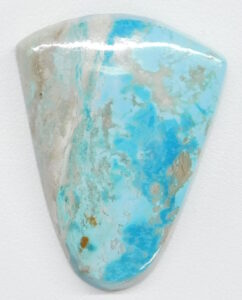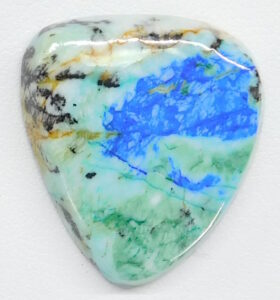By Jennifer Heebner, Editor in Chief
James Carpenter knows that when you cut cabochons, you sometimes need a resin to stabilize the material for jewelry. Enter his nine-year-old proprietary formula that the onetime software engineer turned gemstone cutter worked with a polymer chemist to make. The founder of the Unconventional Lapidarist made his own because existing compounds were hazardous, with low flash points that irritated the skin, were inconsistent in performance, and had overpowering smells. After one too many skin rashes, Carpenter sought a safer solution.

“Lots of resins on the market have hazardous chemicals in them,” he explains. “We made our own specifically to stabilize the Turquoise we cut. Most Turquoise on the market is stabilized with cheap compounds made in China that are full of harmful materials that don’t consistently harden, and they also smell like hell. MMA (Methyl methacrylate) is one of those chemicals and it has been used in the nail industry.”
Specifically, the Food and Drug Administration banned 100 percent liquid MMA formulas in 1974, but “no specific regulations prohibit its use at concentrations lower than 100 percent in cosmetic products,” states the Campaign for Safe Cosmetics. “Across the United States, at least 32 states ban the professional use of methyl methacrylate in nail salons.”
Carpenter opted not to patent his proprietary mix because he would have to disclose his exact ingredients, opening him up to unscrupulous actors overseas who would knock it off for their own sales. And while there are other compounds out there, “most are not designed for our industry,” he explains.
“This is a thermal-cure resin that can be refrigerated after opening, and it will be good for use for up to year,” he continues. “This compound is for the small businesses or individual consumers to use.”

Carpenter’s formula features a host of bio- or plant-based ingredients. It’s a mix that he’s been refining since its development. And since such a big part of his business has been stabilizing gem materials for others, so their gem material is more durable to cut into cabochons, he’s decided to tweak it for commercial use. This means adjusting the ingredients so they don’t harden during shipping, making different viscosities (just like glue), and creating packaging.
“Most Turquoise comes out of the ground as chalk or too soft to cut without it crumbling,” he says. “I’ve been treating other gem dealer’s material, including Mona Lisa Turquoise from Arkansas (where Carpenter is based) for a long time. I’ve been working hard to make the product as clean as possible, to put out a greener, safer product.”
He has, a fact which GIA recognized in the Spring 2022 Gems & Gemology in the “Many Faces of Wavellite. [Wavellite is a niche for Carpenter; it is a 3.5 on the Mohs scale and cannot be cut and polished until it is stabilized.]

This safer, cleaner product comes with a price, of course. Carpenter’s compound is upwards of two-and-a-half times the toxic variety.
“People love how my material works—it doesn’t yellow, it works consistently, and is healthier and safer to use and for the customer to wear—but they have to understand that my chemicals cost twice as much,” adds Carpenter.
Besides poor appearance over time, the other downside of cheaping out and using the toxic stuff is a host of health issues, not just rashes. Think irritation to eyes, nose, throat, and/or respiratory tract and nervous system, all symptoms and reactions that are no bueno. Yikes.
To learn more about this healthier stabilizing mix, reach Carpenter at [email protected].
This is proprietary content for AGTA and may not be reproduced.
